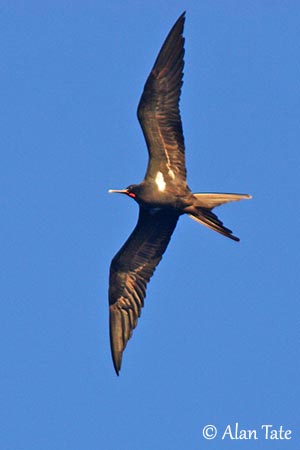
Fr: Frégate ariel
Ang: Lesser Frigatebird
All: Arielfregattvogel
Esp: Rabihorcado Chico
Ita: Fregata ariel
Nd: Kleine Fregatvogel
Sd: Mindre fregattfågel
Port: Tesourão-pequeno
Photographers:
Alan & Ann Tate
AA Bird Photography
Text by Nicole Bouglouan
Sources:
HANDBOOK OF THE BIRDS OF THE WORLD vol 1 by Josep del Hoyo-Andrew Elliot-Jordi Sargatal - Lynx Edicions - ISBN: 8487334105
OISEAUX DE LA REUNION par Armand Barau - Nicolas Barré - Christian Jouanin - Editions Orphie - ISBN : 2877632636
BirdLife International (BirdLife International)
Australian Government – Department of the Environment
Wikipedia, the free encyclopaedia
Page family Fregatidae
Summary cards
Lesser Frigatebird
Fregata ariel
Suliformes Order – Fregatidae Family
INTRODUCTION:
The Lesser Frigatebird is the smallest member of the family Fregatidae. It was formerly placed in the genus “Apagen” due to its small size.
Like numerous bird species, it is threatened by habitat destruction, disturbance, and persecution for food by humans. Three subspecies are recognized.
DESCRIPTION OF THE BIRD:
Biometrics:
Length: 66-81 cm
Wingspan: 155-193 cm
Weight: M: 625-875 g – F: 760-955 g
The adult male has brownish-black plumage overall. However, head, neck, mantle and scapulars show blue, purple and greenish gloss. This species lacks the pale upperwing panel.
On the underparts, we can see a white crescent over central axillaries and anterior flanks.
The long, hooked bill is blackish-grey. The gular pouch is bright red and is inflated during the courtship displays. The eyes are blackish-brown, surrounded by narrow, bare, dark eyering. Legs and feet are pinkish-red.

The female is blackish-brown but duller, with little gloss. The mantle is browner with pale-fringed feathers. On the upperwing, the diagonal paler panel is visible, formed by the pale-edged secondary wing-coverts.
On the underparts, the breast is white with variable buffy tinge, including on foreflanks and axillaries. This white area joins the white hindneck collar. Most of belly is blackish-brown.
The head is dark, including chin and throat. The bill is pale bluish-grey to pale pink. The eyes are dark, surrounded by bare, pinkish-red eyering. Legs and feet are pink.
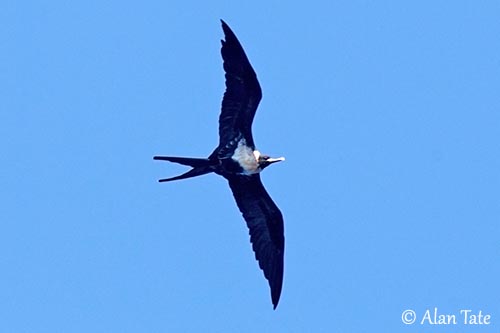
The juvenile has tawny-brown head and neck to central breast, mixed with whitish-buff. There is a broad, dark, pectoral band that separates the breast from the white belly, anterior flanks and axillaries.
On the upperparts, mantle and scapulars show pale brown or pale buff margins. On the upperwing, we can see the pale panel formed by sandy to whitish-buff fringes to lesser and median coverts.
The bill is blue-grey with pale tip. The eyes are blackish-brown with narrow, bare, whitish eyering. Legs and feet are pale greyish or pale flesh.
The young bird will need several intermediate stages to obtain the full adult plumage.
SUBSPECIES AND RANGE:
Three subspecies are currently recognized. They are mainly based on measurements.
F.a. iredalei is found in W Indian Ocean.
F.a. ariel is found in C and E Indian Ocean, SE Asian seas, N Australia to W and C Pacific Ocean.
F.a. trinitatis is found in S Atlantic (Trindade Island and Martim Vaz Island off E Brazil).
HABITAT:
The Lesser Frigatebird usually breeds on remote islands in small bushes and mangroves, generally in low vegetation and even on the ground. It is found in tropical and subtropical waters. It forages in the adjacent ocean.
CALLS AND SONGS:
At nest, the Lesser Frigatebird produces gull-like calls including grating and squealing calls and also hissing. Both sexes perform bill-clapping. When the male is arriving, it gives a series of short whistles, whereas the female utters chicken-like “chuk-chuk-chuk…”
Frigatebirds are silent away from the colonies, but these areas can become extremely noisy during the breeding season, and the displaying males are usually strongly vocal.
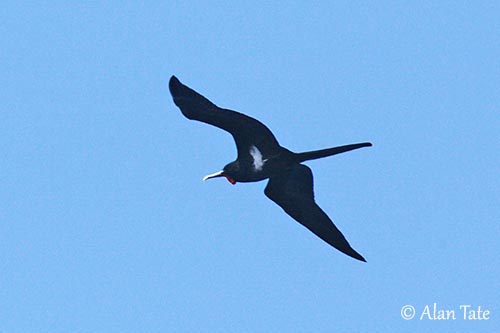
BEHAVIOUR IN THE WILD:
The Lesser Frigatebird feeds primarily on fish, especially flying fish. It also takes squid, seabird chicks and eggs, carrion and fish scraps. The flying fish is caught in mid-flight, but most of prey is taken just above water or floating on, or just below the surface.
Frigatebirds are known for harassing other seabirds while flying. They force them to release the recently caught preys, and the frigatebird snatches them before they fall into the water.
This behaviour is mainly due to the lack of waterproof plumage, and these birds cannot hunt completely in the water.
The Lesser Frigatebird roosts in large groups, perched in trees or bushes, but often on the ground. They can be seen in amazing sunning postures.
During the breeding season, the males display in groups. The bright red gular pouch is inflated and they perform bill-clattering and wing and head waving. They call while displaying to attract the females flying above. The pair formation involves mutual “head-snaking” and preening. Then, they start to build the nest. The nest-site is defended by both birds against intruders.
The Lesser Frigatebird is sedentary, although immatures and non-breeding adults disperse throughout tropical seas in both Indian and Pacific Oceans.
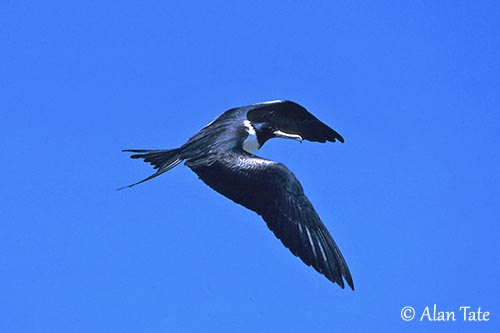
Frigatebirds are efficient fliers, and are able to stay in flight for several days and nights. They use thermal currents and can be seen soaring high in the air, up to 2,500 metres. They perform downwards glides and climb again with few wingbeats, allowing the bird to conserve energy for long-distance flights.
These birds are very clumsy on land and are not able to swim or to take flight from the water.
REPRODUCTION OF THIS SPECIES:
The breeding season can occur throughout the year with the laying mainly in dry season.
The Lesser Frigatebird is a colonial nester and may form groups of up to 100 nests, often with other species such as the Great Frigatebird.
The nest is built by the pair, with the male providing nest materials to the female which builds the nest. This is a stick platform placed in tree, up to 15 metres above the ground.
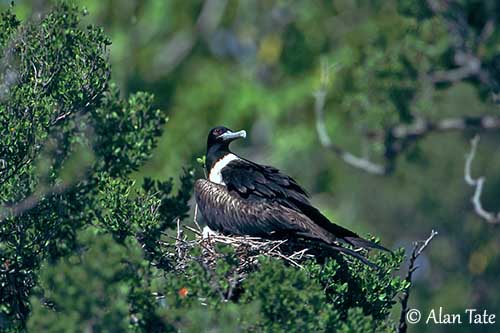
The female lays a single white egg, and both adults incubate during 45 days. At hatching, the chick is naked but it is soon covered with white down. It is fed by both parents. It fledges 20-24 weeks after hatching, but the adults tend and feed it for 4-6 months after fledging.
Due to the long breeding cycle, this species only breeds in alternate years.
PROTECTION / THREATS / STATUS:
The Lesser Frigatebird is not globally threatened. In spite of the usual threats such as habitat destruction, disturbance and human persecution for food, this species has large populations, probably several hundred thousand birds.
The Lesser Frigatebird is not currently threatened.